Thiseio
Thiseio or Thissio (Greek: Θησείο, pronounced [θiˈsio]) is the name of a traditional neighbourhood in downtown Athens, Greece, northwest of the Acropolis, 1.5 km southwest of downtown. Long ago, the name was derived from the Temple of Hephaestus which was mistakenly known as Thiseion in reference to Theseus, the mythical king of Athens, which gave rise to the neighbourhood being named Thiseio.
Thiseio Θησείο | |
|---|---|
Neighborhood | |
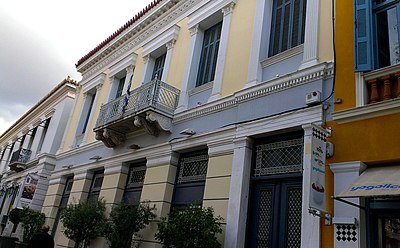 | |
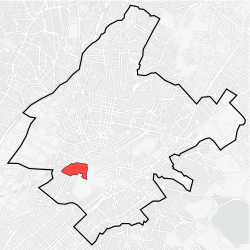 Location within Athens municipality | |
| Coordinates: 37°58′32″N 23°43′00″E | |
| Country | Greece |
| Region | Attica |
| City | Athens |
| Postal code | 118 51 |
| Area code(s) | 210 |
| Website | www.cityofathens.gr |
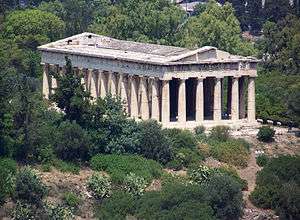
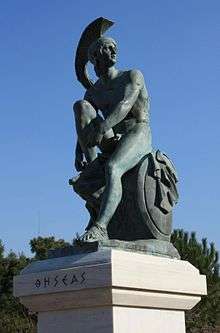
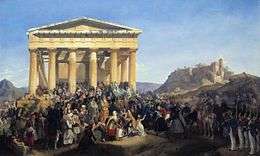
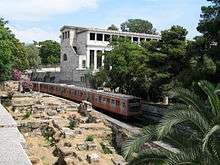
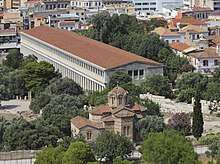
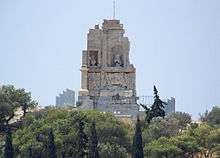
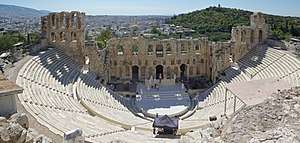
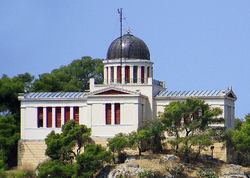
The area has many cafés and cultural meeting points.[1][2][3] Thiseio is served by the nearby Thiseio metro station.
Residential streets
Here is a list of residential streets in the Thiseio area:
- Acamantos Street
- Aethras Street
- Agias Marinas Street
- Aethalidon Street
- Aixoneon Street
- Aktaiou Street
- Amphictyonos Street
- Apostolou Pavlou Street
- Avanton Street
- Chloridos Street
- Demophontos Street
- Dimitriou Aeginitou Street
- Efestion Street
- Eptachalkou Street[4]
- Erysichthonos Street
- Galateias Street
- Hegiou Street
- Iouliou Smith Street
- Irakleidon Street
- Karydi Street
- Kimaion Street
- Lycomidon Street
- Myrmidonon Street
- Nileos Street
- Otryneon Street
- Phaedras Street
- Phlamarion Street
- Pnykos Street
- Poulopoulou Street
- Pygmalionos Street
- Thoricon Street
- Vassilis Street
Archaeological center
Thiseio is surrounded by hills, heights and historical sites which are within a walking distance. The Ancient Agora of Athens, Stoa of Attalos, the Temple of Hephaestus and Kerameikos Archaeological Museum can be entered from Thiseio; all others: the National Observatory of Athens, Acropolis of Athens, Philopappos Monument, Mouseion Hill, Pnyx, which is considered the birthplace of Democracy and the Mount Lycabettus can be easily reached or viewed from Thiseio. The panoramic views of them and their natural surroundings from the Areopagus height are spectacular, especially by night.
Historical landmarks
The historical churches of Agia Marina,[5] the church of Agii Assomati,[6] the church of Agios Athanasios Kourkouris[7][8] and many others are situated in Thiseio.[9] Beautifully restored neoclassical homes and many architectural landmarks make Thiseio a cultural, picturesque, distinguished and peaceful neighbourhood.[10] Due to Thiseio’s position, adjacently to other traditional neighbourhoods, pedestrian-only streets join them. Therefore, Athenians go off for a leisurely walk around Thissio and enjoy cultural events and promenades along narrow serpentine-like paths which twist their way through historical sites.
Apostolou Pavlou is a pedestrianized street which meets Dionysiou Areopagitou Street to form the main pedestrian zone around the archaeological site of Agora from Thiseio to the Acropolis. There are numerous small and friendly boutique shops, restaurants, cafés where people readily are welcomed and invited to socialize at leisure; all set in a quiet enclave.
As one of the many entertainment centers of the city of Athens, Thiseio is rich in history and culture. It has Museums, Art Galleries, a Synagogue, exhibition centers[11] and open-air theatres[12] from which an amazing view of the lush surroundings can be enjoyed.
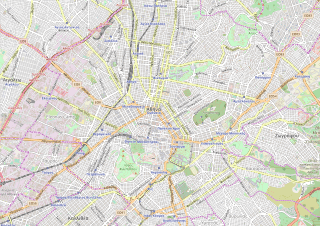
Persons
- Vasilis Avlonitis (1904-1970), actor
- Charalabos (Babis) Drossos (1927 - 2015), Premier League soccer player
- Ms Demetra Kalli, historical researcher
References
- English text and photos of old Athens and Thissio
- View photos from five walking routes and Athens by night
- "Thiseio Photo Guide".
- Click on the photo ‘Ayios Athanasios von Kourkouris’. The church is located at 2 Eptachalkou Street
- Choose ‘Athens-Observatory and Agia Marina church’ from the list. The church of Agia Marina is located very near the National Observatory of Athens
- Agii Assomati church of 11th century
- Agios Athanasios Kourkouris, old church on a rock
- Two churches, the new and the old
- Informative text in Greek
- The sign outside the Thissio Metro station
- Melina Mercouri Cultural Center, at the road junction of Irakleidon and Poulopoulou Street
- Cine-thission-open-air-cinema
